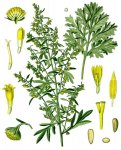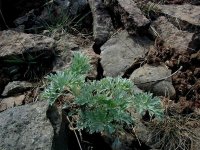wormwood
Artemisia absinthium L.
Botanical characteristics.
Family Compositae. Perennial herbaceous plant with a grayish-silver straight stalk, 60-125 cm high. Has a multi-headed vertical rhizome. Leaves are alternate, twice-, trisudistipistorasschennye below and whole apical. Yellowish flowers are collected in large leafy inflorescences-baskets. Blossoms in June-August. Fruits - numerous small achenes, ripen in September-October.
Wormwood is considered to be the most bitter plant in the world. All parts of the plant produce a strong odor.
Spread. As a weed plant, wormwood is found throughout the European territory of Russia and Western Siberia. It grows on vacant lots, near housing, on roadsides.
Used parts of the plant.
Blossoming flowering tops.
Specific smell of wormwood is caused by an essential oil consisting of thujol alcohol, hydrocarbons (thujone, pinene, cadinene, fellendrop, bisabolone,? -caryophyllene,? -sepinene), 10 sesquiterpenic lactones (absintine, anabsintin, artabsin, etc.) And some other complex chemical compounds.
In the grass, tannins, organic acids, carotene, ascorbic acid are found. In the roots of wormwood contains inulin.
Application.
It is used in folk and scientific medicine mainly as bitterness, which contributes to digestion and stimulation of appetite and restores strength in weakened patients. Wormwood gives the infusion a very bitter taste, reminiscent of chin. It is believed that the bitterness of Artemisia (absintine), like other bitter herbs, increases the excitability of the receptors of the stomach and intestines and thereby stimulates the secretion of the digestive glands of the stomach, intestines, the bile-forming function of the liver and the pancreas.
Wormwood excites the central nervous system and hematopoiesis, is indicated for asthenia, insomnia, anemia and epilepsy.
Preparations of wormwood show antipyretic and expectorant effect and are sometimes used in febrile diseases, malaria, influenza and ARVI.
It is used for gastritis with high acidity, with peptic ulcer of the stomach and duodenum, in colitis, hemorrhoids, ulcerative colitis.
Wormwood is an effective remedy for liver diseases: hepatitis, cholecystitis and cholelithiasis. Adding wormwood to the doses in the treatment of the liver and gallbladder usually significantly enhances their therapeutic effect.
Among other things, wormwood is characterized by diuretic, wound-healing, anti-inflammatory action. Herbal preparations are also prescribed for flatulence, inflammation of the appendages, with dysmenorrhea, as an abortifacient, in kidney disease and kidney stone disease, like anthelmintic, is sometimes used as a mild laxative.
As an external agent, the plant is used for compresses and lotions, as well as in enemas - against pinworms and ascarids.
Contraindications.
An overdose of wormwood causes a strong excitation of the nervous system (up to convulsions and hallucinations), followed by supramarginal inhibition.
Prolonged use of the herb even in small doses can lower hemoglobin, cause nausea and vomiting. Contraindicated in pregnancy.
Preparation.
2 teaspoons of herbs to insist with 1.5 cups of boiling water. The next day, drink 3 times an hour and a half before meals (daily dose). The course of treatment 2 - 3 weeks.
External tincture of wormwood is used for bruises, abrasions and wounds. The tincture is prepared in a concentration of 1: 5 at 70-degree alcohol. Insist 2 weeks at room temperature, filter. The resulting greenish-brown liquid is stored in a sealed container.
With anemia and asthenic condition, tincture of wormwood is taken in small doses: 1 drop of tincture on a thimble of water once a day in the morning on an empty stomach. The course of treatment is three weeks, after a 2-week break the course is repeated. For internal use, the tincture is prepared as follows. Fill a half-liter jar sliced May wormwood and pour vodka, insist 2 - 3 weeks, filter. Activity tincture persists for several years.
Wormwood bitter is a sure remedy against the invasion of caterpillars. Prepare an infusion of wormwood at the rate of 1 kg of grass per 10 liters of water. A week after the first treatment of plants it is desirable to conduct a second treatment.
Wormwood, just like the wild rosemary, beautifully repels the moth. Things in the closet are shifted by the twigs of wormwood for the summer.
Beekeepers widely use wormwood. Firstly, it is used to drive out ants capable of destroying a beehive. To do this, twigs wormwood put on top and under the bottom of the hive. Infusion of wormwood is treated infectious disease of bees - nosematosis, for this bees give sugar syrup with the addition of wormwood tincture (one tablespoon per half-liter of feed). Such therapeutic top dressing is carried out regularly every week, counting from the first flight. To prepare tincture 200 g of ground wormwood pour 1 liter of vodka, insist and use for treatment.
In homeopathy Artemisia absinthium or absinthium is used in feverish states with delirium and hallucinations; Convulsions accompanied by involuntary discharge of feces and urine, foam at the mouth, convulsive compression of the jaws. Absinthium 3x, 3, thus, is shown by the typhoid patient, with tetanus, heavy manic conditions, persistent insomnia with a surge of blood to the head. A characteristic symptom: running (despite the difficult condition, the patient constantly walks).




Comments
When commenting on, remember that the content and tone of your message can hurt the feelings of real people, show respect and tolerance to your interlocutors even if you do not share their opinion, your behavior in the conditions of freedom of expression and anonymity provided by the Internet, changes Not only virtual, but also the real world. All comments are hidden from the index, spam is controlled.